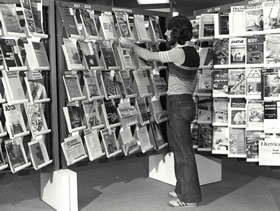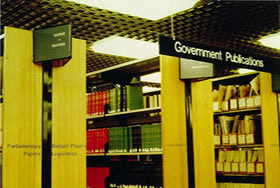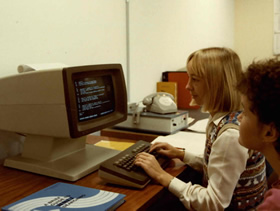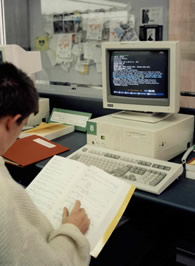
Acquisition budgets
In the early 1980s, both book and journal costs rose sharply due to a decline in the value of the Australian dollar. 7
By 1984, the reduced purchasing power of the dollar combined with budget cuts necessitated a thorough review of the journal collection. 8 With cooperation and input from academic staff, about 400 journal subscriptions were identified for cancellation and 550 'essential' new titles and some 'desirable' titles were selected for purchase.
To help with the ongoing decisions around journal subscriptions, a Serials (Journals) Advisory Committee was set up the following year. The Committee had representatives from all WAIT teaching divisions and considered requests for new journals and made decisions about existing subscriptions. Hard decisions continued to be made over the next few years.
In 1990, for the first time in a decade, the acquisition budget allowed for significant new journal purchases without requiring the cancellation of existing subscriptions. In 1991, the Library’s first subscription to a journal indexing database which also provided full text of some of the indexed articles, signaled a new direction for the development of the journal collection.
The Library’s budgets for acquiring monographs (books, audiovisual and other non-journal items) were low for most of the 1980s. Nonetheless, the government publications collection, newly established in the late 1970s, was substantially developed in this decade.
In 1988, an upsurge in the value of the Australian dollar combined with a budget which almost doubled allowed much needed growth in acquisitions to address significant gaps in the collections. 9 The budgetary situation improved again in 1990 and the Library was able to increase its spending on books and audiovisual items still further.
The number of books in the collection grew from around 273 500 in 1979 to over 364 000 in 1989 while the number of journal titles held decreased from 6 100 to about 5 100. Over the same period, acquisition budgets increased from $502 000 to $1 259 000.
Electronic journal databases (indexing and full text)
Online search and retrieval service by Library staff
For most of the 1980s, the cost and limitations of access to the ever-expanding range of electronic indexing databases (indexes to published information such as journal articles and books) meant that Library staff provided a search and retrieval service for clients. In 1981, of the 270 online searches undertaken by librarians, 133 were for academic staff, 69 for students and the remainder for private clients. 10
Searches were carried out on a growing range of electronic journal indexing databases and other sources that were only available via library subscription and through dial-up facilities to networks such as AUSINET, DIALOG, Medline and Orbit. In 1983 the Library gained access for the first time to the European Space Agency Information Retrieval System and the Bibliographic Retrieval Service.
A modified service which was limited to retrieving just 12 references was introduced in 1982 and was primarily aimed at students. The cost for this ‘rapid search’ was a nominal $5 ($2 for Medline), compared to the $15 to $25 cost of a comprehensive search.
In 1986, almost 600 searches were undertaken, of which about 40% were rapid searches.
As in the 1970s, once useful references were found, they were checked against the printed listing of journals the Library held to see if the items were available on the shelves. If not, the holdings of other WA libraries could be checked or the items could be requested through interlibrary loan.
Independent search and retrieval by clients
In 1989, the first searchable journal indexing database on compact disc was set up for client use on a workstation in the reference collection area of Robertson Library. The arrival of ERIC (Education Resources Information Centre) and later in the year, ABI/Inform (a business index on CD), heralded the beginning of a major change in direction for library services in this area. Patrons were able to carry out free online searches for themselves rather than requesting and paying for searches to be undertaken by librarians.
The relative ease of searching and the ability to download freely the records found, versus paying per print, were clear incentives to clients who enthusiastically took up the opportunity to search independently.
Over the next few years the range of indexing databases acquired by the Library continued to grow and, where possible, the databases were networked for access on multiple workstations, signaling the first step towards an electronic library. By the end of 1991, 19 databases were on offer of which 13 were networked, allowing for simultaneous use by multiple users.
In addition to the databases on CDs, Library patrons could gain online access to scores of Australian and overseas electronic databases via the Australian Academic and Research Network (AARNET). 11
The arrival of electronic journal databases with full-text
In 1991, the Library, together with Curtin’s Division of Business and Administration, purchased Business Periodicals On disc (BPO), an indexing database for business resources, comprising hundreds of CDs. This boosted the number of business journals in the collection by 76% with 300 out of the 800 titles indexed providing full text articles for reading and printing. BPO was installed on a bookable computer terminal in Robertson Library.
 The current journals display, early 1980s.
The current journals display, early 1980s.
The journal reviews of the 1980s made hard decisions about what subscriptions the Library could afford. In 1986, the review resulted in a net cancellation of approximately 500 journals ie 800 subscriptions were cancelled and 300 new subscriptions were placed.
Two years on in 1988, a further review led to 30 journal subscriptions being cancelled and more than 200 new subscriptions being approved.
 The Government Publications collection on level four, c1982.
The Government Publications collection on level four, c1982.
The collection brought together selected items including annual reports, law reports and statistical publications issued by governments and international organisations. This allowed more efficient collection development and easier access for clients. A printed keyword out of context (KWOC) listing was created to assist users to locate titles of interest.
 A librarian searching online databases for a client, late 1980s.
A librarian searching online databases for a client, late 1980s.
Costs for the search service related both to the time spent online in a particular database and the number of references retrieved and printed.
To minimise costs, search terms were prepared beforehand by trained Library staff in collaboration with clients.
 A client using ERIC on CDROM while checking the Library’s journals holdings on the printed journal listing, c 1990.
A client using ERIC on CDROM while checking the Library’s journals holdings on the printed journal listing, c 1990.
The CDROM indexes proved very popular with clients as an efficient alternative to manually searching printed journal indexes and abstracts.
At busy times during semester, the workstations were fully booked several days ahead.
A big advantage of the full-text databases, and one much appreciated by clients, was that the article itself was sometimes immediately available, not just the reference to it, thus eliminating the need to search the Library’s journal holdings.